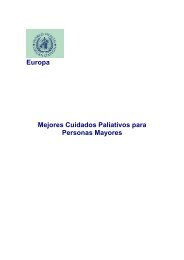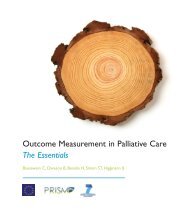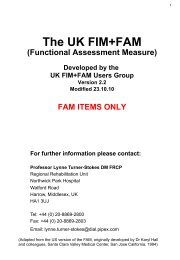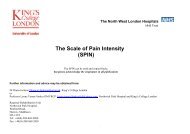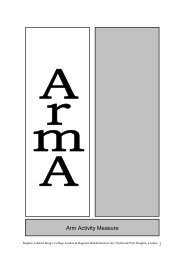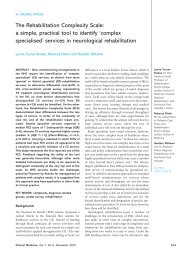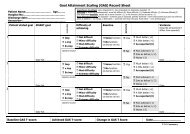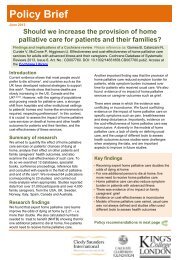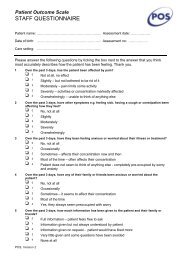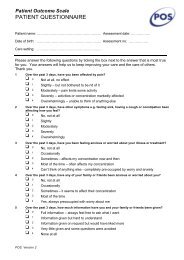Clinical Rehabilitation - King's College London
Clinical Rehabilitation - King's College London
Clinical Rehabilitation - King's College London
Create successful ePaper yourself
Turn your PDF publications into a flip-book with our unique Google optimized e-Paper software.
Development of Northwick Park Therapy Dependency Assessment 923<br />
properly defined. Patients with neurological disabilities<br />
have widely varying needs for rehabilitation,<br />
often involving several disciplines. Simply<br />
recording hours of therapy input has little meaning<br />
unless the nature of interventions can be also<br />
be described. Many authors have called for<br />
practice-based research to ‘open the black box’,<br />
in order to provide clearer description of the rehabilitation<br />
content. 4 A number of tools have been<br />
developed to facilitate the systematic recording of<br />
therapy interventions, 5–12 which include tools to<br />
describe the type of interventions offered for<br />
patients with stroke 5,7–10 and spinal cord<br />
injury. 11,12 However, these can only be applied to<br />
describe interventions that were actually given,<br />
rather than looking at what might be needed.<br />
Moreover, existing tools focus only on physical<br />
interventions (physiotherapy, occupational therapy<br />
and in some cases speech and language<br />
therapy 8 ) and omit other interventions such as<br />
psychology, dietetics and social work, which play<br />
an important role in holistic neurological rehabilitation<br />
programmes.<br />
Since the mid-1990s, work has been underway at<br />
Northwick Park Hospital in the UK to develop a<br />
comprehensive set of tools for rehabilitation,<br />
which are practical to apply in the course of routine<br />
clinical practice; and which may be used to<br />
measure nursing and therapy intervention, in<br />
relation to need, and to quantify this in terms of<br />
staff time. A common underlying principle of these<br />
instruments is that they are designed to be applied<br />
both prospectively to measure ‘needs’ for rehabilitation<br />
intervention, and retrospectively to<br />
describe what the patient actually ‘gets’, so that<br />
in future they could be applied as a framework<br />
for quantifying gaps in service provision. They<br />
also include a computerized algorithm, which<br />
translates the description of dependency into a<br />
generic estimation of implications for staff time.<br />
The Northwick Park Nursing Dependency Scale<br />
(NPDS) was published in 1999 as a tool to assess<br />
nursing needs of patients in rehabilitation settings.<br />
It translates, by means of a computerized<br />
algorithm (the Northwick Park Care Needs<br />
Assessment) into an estimate of care hours<br />
required. 13 It is shown to be a valid measure of<br />
nursing needs 14,15 and has been increasingly<br />
applied in the context of routine clinical practice<br />
in the UK, 16 as well as abroad. 17<br />
In 2004, a project grant was awarded by the UK<br />
Department of Health (Grant ref. 030/0066) to<br />
develop an equivalent tool to assess therapy<br />
dependency. 18 The Northwick Park Therapy<br />
Dependency Assessment (NPTDA) was developed<br />
through an iterative process over two years.<br />
This paper provides a brief description of its<br />
development and initial validation.<br />
Methods<br />
Tool development<br />
The setting for this development and initial<br />
evaluation was the Regional <strong>Rehabilitation</strong> Unit<br />
at Northwick Park Hospital. The unit provides a<br />
tertiary specialist inpatient neurorehabilitation<br />
service for younger adults (mainly aged 16–65<br />
years) with complex neurological disabilities. An<br />
experienced multidisciplinary staff team includes<br />
specialty-trained rehabilitation doctors and<br />
nurses; and a range of allied health professions<br />
which include physiotherapy, occupational therapy,<br />
speech and language therapy, psychology,<br />
dietetics, and social work, all of whom contributed<br />
to the project. Ethics permission was obtained<br />
from the Local Research Ethics Committee.<br />
Development of the NPTDA involved an<br />
iterative process of consultation with senior<br />
multidisciplinary team members to identify the<br />
factors that describe requirements for different<br />
levels of therapy intervention. This led to the<br />
development of a draft tool in 2004. Over the<br />
next 18 months, successive periods of crosssectional<br />
application of the tool provided an extensive<br />
prospective observational dataset. Refinement<br />
through serial analysis and team reflection in the<br />
context of clinical use ensured content validity for<br />
this setting, and the NPTDA evolved to its final<br />
form in late 2005. A full description of the early<br />
development and testing process is beyond the<br />
scope of this article, but is detailed in the Department<br />
of Health project report. 18<br />
The Northwick Park Therapy Dependency<br />
Assessment (NPTDA) tool<br />
The NPTDA is a measure of therapy intervention<br />
designed for use in specialist neuro-rehabilitation<br />
settings, where high intensity rehabilitation is<br />
provided by a multidisciplinary team.




